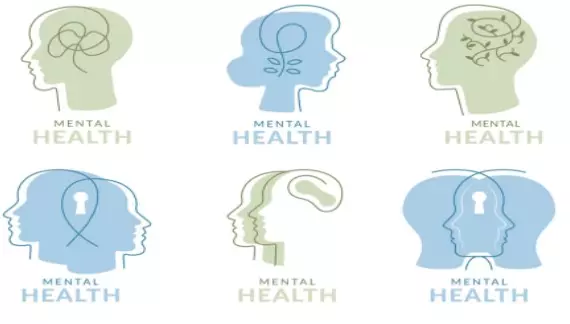
The number of individuals suffering from mental disorders continues to increase worldwide. Psychiatric diseases, which can be temporary or chronic, affect a person's relationship with other people and their daily life. Psychological illnesses can be difficult to define. However, it is important to know that these diseases are characterized by both mental distress and impairment in functionality in many areas of life.
Psychological diseases are diseases that can be difficult to be recognized and accept by society, and therefore their treatment is delayed. The cause of many mental health disorders that people experience in their minds, sometimes outweighing their physical symptoms and seriously affecting their emotional world, is still not fully elucidated.
In this article, we will try to give information about the most common mental disorders.
-
Anxiety Disorders
Anxiety is a healthy emotion that, when experienced in a normal way, helps us to protect ourselves against danger, stay motivated, and to pay attention. It helps us to solve our problems healthily. The "normality" measure of the anxiety experienced is whether the perceived danger is real or not.
Anxiety, which is an extremely effective and healthy emotion in life, can sometimes intensify in a way that negatively affects a person's life. In such cases, anxiety can become uncontrollable and seriously reduce our quality of life.
What is Anxiety disorder? When should we suspect that our anxiety is turning into an anxiety disorder? If there is a persistent feeling of unexplained distress, anxiety, or feeling like you're about to receive bad news, you need to see a specialist. This psychological disorder is 2 times more common in women than men. It is recommended to seek help from a specialist if the person exhibits excessive delusional behaviors and experiencing severe anxiety certain events on most days for at least 6 months.
We can list the types of anxiety disorders as follows:
- Generalized anxiety disorder
- Panic disorder
- Agoraphobia
- Social anxiety disorder
- Separation anxiety disorder
- Selective mutism
While each anxiety disorder has its own characteristics, most respond well to two treatments: psychotherapy or "talk therapy" and medications. These treatments can be given alone or in combination.
Here are some things you can do to relieve anxiety:
- Use deep breathing techniques.
- Whether in the form of oil, incense, or candles, scents like lavender, chamomile, and sandalwood can be very relaxing.
- Anxiety is a future-oriented state of mind. Focus on the present instead of worrying about what will happen next.
- Remind yourself that what you are experiencing during the attack is a panic attack, it is actually a harmless and temporary situation and there is nothing you need to do.
- Avoid sugar as soon as you feel the crisis is about to begin.
- Take a walk or exercise for 15 minutes.
- Watch TV series or videos that you find very funny, it will be good for you to laugh.
- Call and talk to someone you trust and understands your situation.
-
Post-Traumatic Stress Disorder
Throughout our lives; we encounter many events that cause distress, and sadness, and make us feel bad about ourselves. While some of these events do not affect us much, others can cause psychological trauma and affect our thoughts, emotions, and choices.
As it is known, every individual who has experienced a traumatic event may develop reactions after trauma. These feelings decrease over time and return to normal. Fear causes the release of certain hormones in your body and changes in alertness, blood pressure, heart rate, and breathing. People with PTSD mental disorder feel stressed and scared long after the trauma is over. In some cases, PTSD symptoms may begin later. They can come and go over time. However, this psychological problem is known as a treatable disorder.
What causes PTSD:
- Having had a severe childhood trauma
- Going through a prolonged traumatic event
- Coping with extra stress after the event, such as losing a loved one, pain and injury, loss of a job or home
- Having a history of mental illness or substance use
- Natural disasters such as earthquakes, floods and fires, human-induced traumas such as torture, war and rape
Getting effective treatment as soon as possible after the symptoms and signs of PTSD appear is of great importance to reduce symptoms.
-
Attention-Deficit Hyperactivity Disorder (ADHD)
Attention deficit hyperactivity disorder, abbreviated ADHD, is the most commonly diagnosed behavioral disorder in childhood. In children, an average of 1-3 students in a 50-person class are affected by this problem.
Mobility is normal during childhood. Actions such as running, shouting, and jumping during play are normal behaviors expected from children. However, this activity in children with ADHD is visibly different from other children. Compared to their peers, these children's endless energy makes the difference easily noticed. In general, the "hyperactive" part of Attention Deficit and Hyperactivity Disorder (ADHD) in these children stands out first.
We can list the most common ADHD symptoms as follows:
- Persistent inattention
- Showing sudden and unruly behavior without thinking about future reactions
- Difficulty implementing and sticking to long-term plans
- Sensitivity and mobility well above normal limits
- Getting angry too quickly, fighting, talking too much, playing dangerous games, having frequent accidents and causing injuries
The diagnosis of attention deficit hyperactivity disorder in children and adolescents is determined as a result of a clinical interview and detailed evaluation by a child psychiatrist. The symptoms of ADHD can be successfully controlled with drug treatment together with psychosocial interventions.
